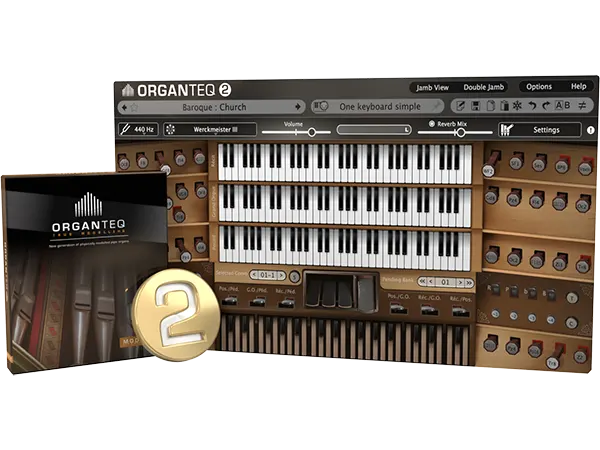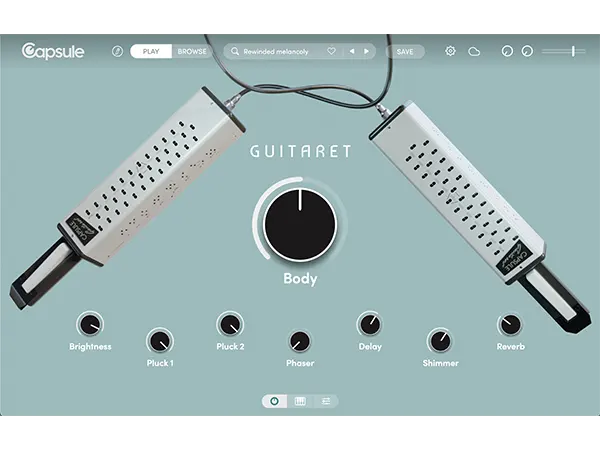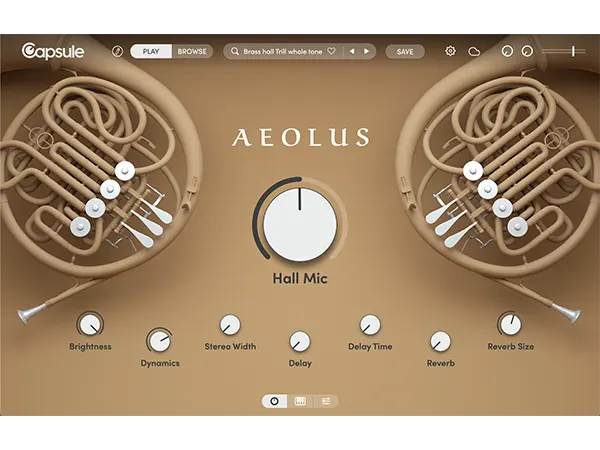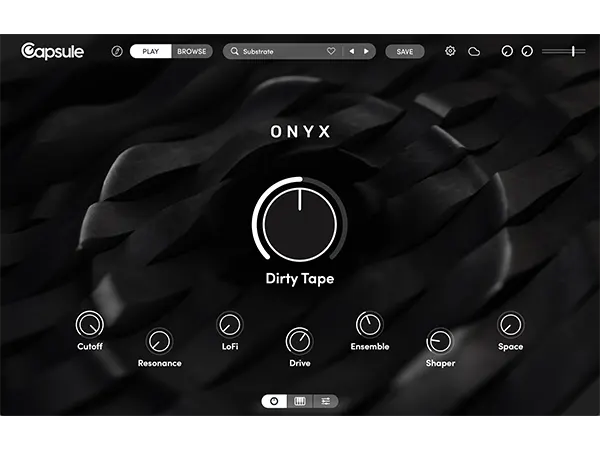Modartt Organteq 2
Modartt Organteq 2: Most advanced physically modelled pipe organ. New generation of physically modelled pipe organs.
Electronic Delivery
PLEASE NOTE: This product is delivered via secure, electronic delivery. You will receive the full product license (with instructions) direct to your email. Enjoy a safe and fast way to get the latest version and full support direct from the manufacturer.
Description
Organteq offers realtime synthesis of organ pipes sound based on physical model. By capturing the complex physics of flue and reed pipes, it brings a vivid instrument of stunning playability and breathtaking realism.
Everything in Organteq can be tweaked – from the composition of the organ to the sound of each pipe – making it possible to reproduce a wide variety of existing organs or to explore unknowns musical lands.
Organteq offers over four thousand pipes, inspired from many great organ builders of French Romantic and German Baroque periods : A. Cavaillé-Coll, G. Silbermann, T. Tröst and many others.
These 68 organ stops, ranging from 32′ to 1′, can be assigned to three manual keyboards with a five-octave range, and a pedal keyboard with thirty-two notes.
Every pipe of every stop can be voiced to your taste through many user parameters.
Physical modelling
The core synthesis algorithms of Organteq are based on aeroacoustics of the organ pipes. The equations of the air jet growing and impacting the labium, the equations of the beating reed, as well as the ones that describe the pipes resonances, are used to synthetize organ pipe sounds.
In addition, the acoustics radiation from the pipes ends to the division box first, and then to the main space. This makes it possible to listen to the organ sounds in various configurations.
The use of physical modelling has many advantages:
- Small file size – The installation file size is just 30 MB (Megabytes) in contrast to sampled virtual organs which require up to 64 GB (Gigabytes).
- Quick load time – Organteq loads quickly thanks to the limited file size.
- Variability – When playing a repeated note on a real organ, you can hear subtle variations in the attack, even with sustain. The physical model reproduces these variations. Thus, you are not stuck to the static nature of samples.
- Tweak the model – Access to physical parameters makes it possible to tweak the sound of the pipes in unique ways, including reverb effects.
Organteq Console
- Three manual keyboards – of five-octave range
- 1 pedalboard – of 32 notes
- 50 assignable stop slots – to customize your organ composition
- 3 expression pedals – assignable per stop and per division, and tweakable
- 4 tremulants – assignable per stop and per division, and tweakable
- 6 couplers – to link one keyboard to another with octave-transposition options
- 4 monophonic couplers – to send only the bass line or the melody from one keyboard to another perfect for the user who do not have pedalboard or MIDI organ console
- 24-step crescendo pedal – easily configurable
- 100 combination banks – of 10 combination slots each to create and store your organ sounds palette
- easy combination navigation – for a smooth and controlled performance
- Tutti & General Cancel – Unleash the full power of your organ!
Organteq also offers alternative console views (or “Jamb Views”) that gathers all your organ informations and controls in a condensed way.
The Jamb Views are touch screen compatible, detachable, and let you activate multiple stops within a single drag.
A dual-split option for multiple screens is also include.
Tweak your organ
From the powerful 32′ bass pipes to some soft-voiced flue pipes, roaring reeds and exciting mixtures, 68 carefully crafted organ stops are assignable to any of the console 50 stop slots.
Build and modify your organ composition easily with a smooth and streamlined GUI (copy/paste/swap/move/insert, …).
Stop voicing
Voice and harmonize each stop to your taste … and even individual pipes!
Tweak the parameters of the physical model and adjust the brightness, wind jitter, chiff – and more! – according to your needs and tastes!
Expression pedals
Expression pedals controls the opening of wooden boxes in which organ pipes are enclose.
Organteq offers 3 configurable expression pedals : each one of them can be easily assigned to one or several keyboard divisions, but also to a selection of individual stops.
Tweak and modify each pedal effect with filter shapes for closed and open pedal position.
Tremulants
Tremulants are a mechanical device that modulate the upstream air flow that feeds the organ pipes. These modulations affect the pitch, intensity and spectral content of the sound… and are generated by the physical model itself – not by a post-processing audio effect!
Organteq lets you assign and customize 4 different tremulants: choose which keyboards and stops that should be affected by each tremulant, and adjust their amount, rate, and shape.
Crescendo pedal
The Crescendo pedal triggers a sequence of stops switches, but also coupler and tremulants to help you create great dynamic playing.
It has 24 fully configurable steps. Its configuration is smooth and straightforward thanks to the streamlined GUI and its detachable window.
Couplers
Couplers let you play simultaneously the pipes of one division from an alternative manual.
Organteq proposes 6 customizable couplers, with octave transpositions options. Octave and sub-octave couplers within a single keyboard are also possible.
Monophonic Couplers
Monophonic couplers are an exciting and new feature that send only the bass line or the melody played on one keyboard to another. The monophonic couplers behaviour is carefully designed to offer a stunning playability and to provide exciting registration possibilities!
Combinations and Banks
Create and store your organ sounds palette with 100 banks of 10 combinations each. Easy snapshots from the main UI. Optimised management of banks and combinations for a smooth and controlled performance.
Division Box settings
In real organs, each keyboard is associate to a division and all the pipes of a division are enclose in a single wooden box. Of course, these wooden boxes have some acoustical effects and influence the sound of the organ.
Organteq allows you to control these effects : for each division, you can tune its gain, its associated EQ, the size of the division box and its presence in the final mix.
Output settings
Play with the sound space : adjust the stereo width and the C/C# spatial separation of organ pipes.
A new routing audio output matrix of up to 8 channels.
Reverb
The Reverberation plays a huge role in the «organ sound» : the space in which the organ is place (a cathedral or a much smaller room) is also part of the instrument!
Features
- Advanced Physical Modeling
- Versatile Console
- Pipe-specific parameters
- Ergonomic UI
- Large collection of unique stops
- Advanced output settings
- Moe than 30 built-in presets
- Seamless DAW integration
Tech Specs
MAC
OS X 10.7 or later
Plugins: VST-2, VST-3, AU, AAX, STAND-ALONE
WINDOWS
Windows 7 or later
Plugins: VST-2, VST-3, AAX, STAND-ALONE
LINUX
Linux x86
Plugins: VST-2, VST-3, AAX, STAND-ALONE
* Any references to any brands on this site/page including reference to brands and instruments, are provided for description purposes only. For example references to instrument brands are provided to describe the sound of the instrument and/or the instrument used in the sample. Plugin Max do not have (nor do they claim) any association with or endorsement by these brands. Any goodwill attached to those brands rest with the brand owner. Plugin Max or its suppliers do not accept any liability in relation to the content of the product or the accuracy of the description.






Reviews
There are no reviews yet.